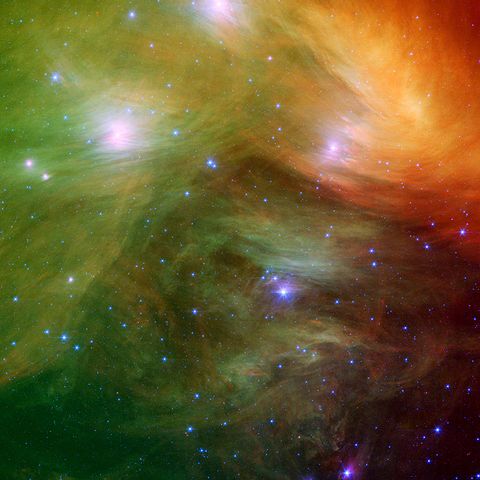
File:Pleiades Spitzer big.jpg

| |
This is a file from the Wikimedia Commons. Information from its description page there is shown below.
Commons is a freely licensed media file repository. You can help. |
Summary
| Description | Pleiades (M45, Seven Sisters) open cluster - infrared image from NASA's Spitzer Space Telescope |
| Date | exposure: September 2004 release: 2007/04/12 |
| Source | http://gallery.spitzer.caltech.edu/Imagegallery/image.php?image_name=ssc2007-07a |
| Author | John Stauffer (Spitzer Science Centre, Caltech) credits: Credit: NASA/JPL-Caltech/J. Stauffer (SSC/Caltech) |
| Permission ( Reusing this file) |
http://www.spitzer.caltech.edu/Media/mediaimages/copyright.shtml |
Licensing
| Public domainPublic domainfalsefalse |
 |
This file is in the public domain because it was solely created by NASA. NASA copyright policy states that "NASA material is not protected by copyright unless noted". (See Template:PD-USGov, NASA copyright policy page or JPL Image Use Policy.) |
 |
 |
Warnings:
|
File usage
Metadata
| Image title | The Seven Sisters, also known as the Pleiades, seem to float on a bed of feathers in a new infrared image from NASA's Spitzer Space Telescope. Clouds of dust sweep around the stars, swaddling them in a cushiony veil. The Pleiades, located more than 400 light-years away in the Taurus constellation, are the subject of many legends and writings. Greek mythology holds that the flock of stars was transformed into celestial doves by Zeus to save them from a pursuant Orion. The 19th-century poet Alfred Lord Tennyson described them as "glittering like a swarm of fireflies tangled in a silver braid." The star cluster was born when dinosaurs still roamed the Earth, about one hundred million years ago. It is significantly younger than our 5-billion-year-old sun. The brightest members of the cluster, also the highest-mass stars, are known in Greek mythology as two parents, Atlas and Pleione, and their seven daughters, Alcyone, Electra, Maia, Merope, Taygeta, Celaeno and Asterope. There are thousands of additional lower-mass members, including many stars like our sun. Some scientists believe that our sun grew up in a crowded region like the Pleiades, before migrating to its present, more isolated home. The new infrared image from Spitzer highlights the "tangled silver braid" mentioned in the poem by Tennyson. This spider-web like network of filaments, colored yellow, green and red in this view, is made up of dust associated with the cloud through which the cluster is traveling. The densest portion of the cloud appears in yellow and red, and the more diffuse outskirts appear in green hues. One of the parent stars, Atlas, can be seen at the bottom, while six of the sisters are visible at top. The Spitzer data also reveals never-before-seen brown dwarfs, or "failed stars," and disks of planetary debris (not pictured). John Stauffer of NASA's Spitzer Space Telescope says Spitzer's infrared vision allows astronomers to better study the cooler, lower-mass stars in the region, which are much fainter when viewed in optical light. Stauffer, who admits to being biased because the Pleiades is his favorite astronomical object, says the cluster is the perfect laboratory for understanding the evolution of stars. |
|---|---|
| Author | Spitzer Space Telescope |
| Copyright holder | http://www.spitzer.caltech.edu/Media/mediaimages/copyright.shtml |
| Width | 2,855 px |
| Height | 2,855 px |
| Compression scheme | LZW |
| Pixel composition | RGB |
| Orientation | Normal |
| Number of components | 3 |
| Horizontal resolution | 300 dpi |
| Vertical resolution | 300 dpi |
| Data arrangement | chunky format |
| Software used | Adobe Photoshop CS3 Macintosh |
| File change date and time | 15:28, 11 April 2007 |
| Colour space | sRGB |
More information
SOS Children has brought Wikipedia to the classroom. SOS Children's Villages believes that a decent childhood is essential to a happy, healthy. Our community work brings families new opportunities through education, healthcare and all manner of support. Go to http://www.soschildrensvillages.org.uk/sponsor-a-child to sponsor a child.
